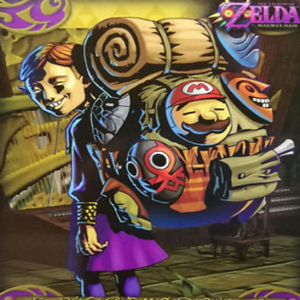
Happy Mask Salesman
CBUB Wins: 1
CBUB Losses: 3
CBUB Ties: 0
Win Percentage: 25.00%
Added by: Z451
The Legend of Zelda: Ocarina of Time is the fifth main entry in The Legend of Zelda series, and the first to both be on the Nintendo 64 and in 3D. It was developed by Nintendo, with series protagonist Link tasked with rescuing Princess Zelda and Hyrule from the villain, Ganon. Link interacts with a variety of characters throughout the game, some friendly and some antagonistic. The game's cast had various points of inspiration, including works by J. R. R. Tolkien and the TV series Twin Peaks. The staff was told to focus less on the plot and more on the characters, and emphasis was put on giving them interesting and realistic animations to make them more real. Some members of the cast were also intended as references to previous The Legend of Zelda games.
Inspiration for the characters in Ocarina of Time came from a variety of sources, including J. R. R. Tolkien, whose Hobbit race served as the basis for the Deku Scrubs. Shigeru Miyamoto also said that the characters were partially inspired by the American television series Twin Peaks. Miyamoto wanted various characters to fulfill certain roles, citing Kaepora Gaebora being a "grandfather figure" and for girl characters like Saria and Malon to be included since Link is a boy. In a 1999 interview Miyamoto said he focuses less on plot and more on making the cast interesting, feeling that the characters are the most interesting part of a The Legend of Zelda game. The game has more than 60 characters, with each taking about 2-3 days to create. Character designer Yoshiki Haruhana recounts a fellow staff member saying that the characters he makes, such as Dampé the Gravekeeper, are freaks, though he notes that this is not his intention. Character designer Satoru Takizawa noted that they intended to make them feel real, and thus gave them interesting and realistic animations. Takizawa also noted that character creation was difficult, as he was worried about changing the initial character designs too much, The game made references through its characters to earlier games; for example, the six sages other than Princess Zelda are named after towns from Zelda II: The Adventure of Link, and Malon and Talon are based on Marin and Tarin from The Legend of Zelda: Link's Awakening.
The incarnation of Link introduced in Ocarina of Time appears as the protagonist The Hero of Time in Ocarina of Time and Majora's Mask, and as a supporting character in Twilight Princess as The Hero's Shade, with his spirit training the protagonist, his descendant the Hero of Twilight (also named Link).
Epona is Link's horse, who was introduced in Ocarina of Time and appears in other games in the series, including Majora's Mask, The Minish Cap, Twilight Princess, Breath of the Wild, and Tears of the Kingdom, the former being the same horse as in Ocarina of Time. She comes to Link's aid after being called by Epona's Song, which he plays on the ocarina in Ocarina of Time and Majora's Mask, and on a blade of "horse grass" in Twilight Princess. Shigeru Miyamoto said that Epona was chosen as Link's main mode of transport so that he could get in contact with other characters. In Ocarina of Time, she is first encountered at Lon Lon Ranch, where Malon teaches young Link "Epona's Song". Later, Link frees her from Ingo's control and she becomes his steed. Charlotte Krol of NME chose the experience of riding Epona in Ocarina of Time as one of the most enjoyable aspects of the game, noting that the speed at which players traverse the game world felt revolutionary at the time. Chris Hoffman of GamesRadar praised the subtle bond between Link and Epona and described her as his steadfast companion throughout the game.
CBUB Match Record:
No Regular Play Records Available
Fantasy Teams Season 14 Record:
View the historical team line-up
| Result | Opponent | My Score | Their Score | |
|---|---|---|---|---|
| Loss | Anna (Fire Emblem) | 0 | to | 8 |
| Loss | Varric Tethras | 1 | to | 4 |
| Win | Gurd | 4 | to | 1 |
| Loss | Toad (Nintendo) | 1 | to | 5 |
